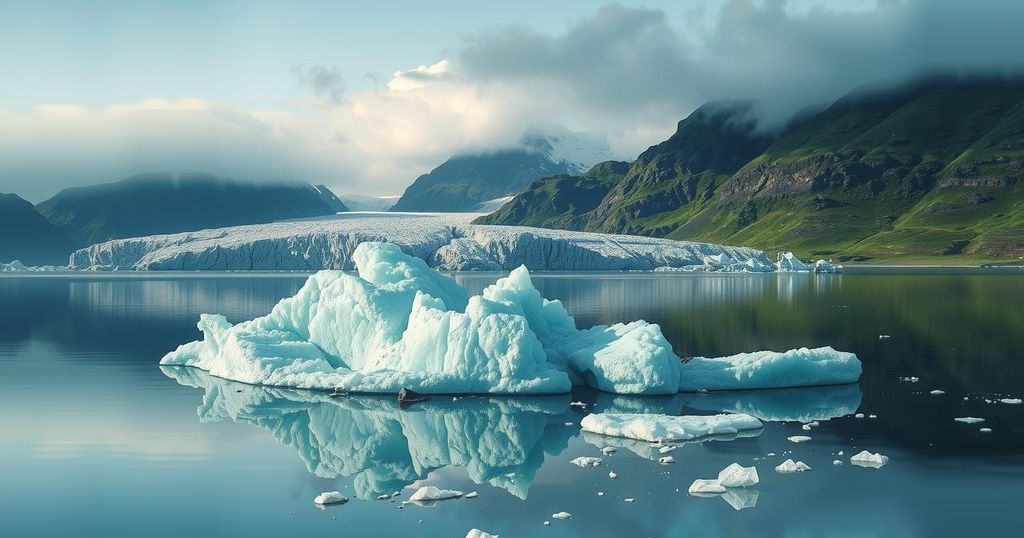Colombia’s glaciers, particularly in the Sierra Nevada del Cocuy, are at severe risk of disappearing due to climate change, with predictions indicating they may vanish within 30 years. Local communities, heavily reliant on glacial meltwater, are already feeling the impacts, including water shortages. Experts highlight the urgency of addressing the environmental degradation and exploring adaptive measures for a future without glaciers.
In the Sierra Nevada del Cocuy, Colombia, Edilsa Ibañéz Ibañéz expresses concern over the significant reduction of glaciers, stating, “We used to think the ice would be eternal. Now it is not so eternal. Our glaciers are dying.” This region, once rich in glacial ice, has lost more than 90% of its ice since the 19th century, with only six glaciers remaining in the entire country.
The transformations in the landscape are stark; dry rocks are now visible where snow once blanketed the region. Historical markers now indicate where the glaciers once extended, emphasizing the alarming extent of their retreat. As Ibañéz notes, the ice that once took ages to accumulate is vanishing at an unprecedented rate.
Rising global temperatures and erratic weather patterns threaten not just the Sierra Nevada del Cocuy, but all six of Colombia’s remaining glaciers. Experts predict that Colombia may face the complete loss of its glaciers within three decades, following Venezuela, which lost all its glaciers in 2024. Mathias Vuille, an atmospheric science professor, warns, “Even if we were to very aggressively reduce greenhouse gas emissions, it wouldn’t be enough.”
The Santa Isabel glacier in Los Nevados national park is expected to be the first to disappear, potentially within the next five years. Matteo Giraldo, a local resident, has witnessed the glacier’s rapid decline, sharing, “I’ve cried for the situation with the glacier.” The alarming rate of ice loss is not only a personal tragedy for those connected to the glacier but signals broader environmental implications for the region.
The melting glaciers serve as vital water reservoirs for communities in high-altitude regions. Vuille states, “Glaciers are essential, like a reservoir. It is your only water source if you live very close to the glacier.” The diminishing ice reserves endanger the water supply for countless families, particularly those in close proximity to the glaciers like Ibañéz’s community, who are unaware of the looming crisis.
Community leader Hernando Ibañéz Ibañéz expresses deep concern for the future, noting that two hundred fifty families currently depend on a single aqueduct that is at risk of drying up in the next decade. The critical loss of glaciers indicates a broader environmental crisis affecting Colombia’s water supply, exacerbated by recurring drought and rationing in cities like Bogotá.
Colombia’s páramos, unique high-altitude regions vital for water storage, are threatened by the loss of glaciers, which provide essential meltwater. The impact of glacier loss on these ecosystems remains uncertain, as scientists like Jorge Luis Ceballos emphasize the profound changes occurring within both the glaciers and the surrounding ecosystems, stating, “The glacier is an alarm that is sounding.”
The decline of the glaciers is alarming and presents an environmental heritage loss alongside a significant water source depletion. Ceballos affirms the urgency of research to prepare for a glacier-less future, recognizing, “When we lose a glacier, it’s not just water. It is also a loss of environmental heritage.” Families like Doris Ibañéz Cristancho’s, who have a long history in the region, are concerned about witnessing the end of their glacial heritage, reflecting on how changes in the mountain landscape evoke deep nostalgia.
The glaciers of Colombia symbolically and literally mark a crucial aspect of the nation’s environmental identity. There is a pressing need for concerted action and research to address these impending challenges and adapt to the inevitable loss of these significant natural resources.
The glaciers of Colombia are rapidly diminishing due to rising temperatures and changing weather patterns, threatening water supplies for local communities. With expert predictions suggesting that these glaciers may vanish within the next three decades, the situation calls for urgent awareness and action. The cultural and environmental loss associated with this decline emphasizes the need for adaptation strategies as the nation faces a future without its glaciers.
Original Source: www.theguardian.com




